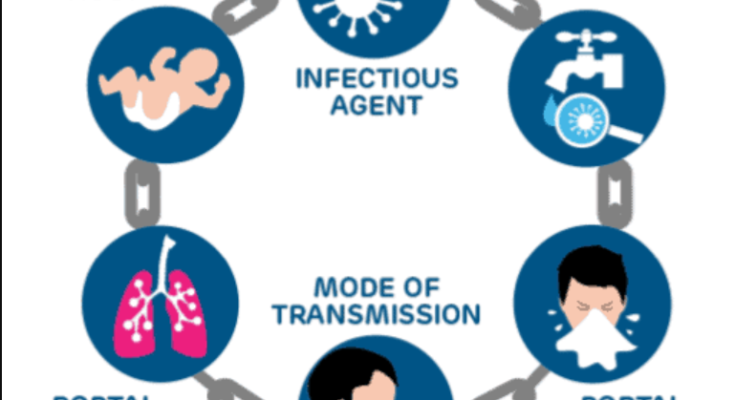In the realm of public health, understanding the weakest link in chain of infection is crucial for controlling the spread of infectious diseases. The chain of infection illustrates how infections occur and spread, and identifying the weakest link can significantly enhance prevention strategies. This article explores the chain of infection, its components, and how to effectively break this chain to protect public health.
What Is the Chain of Infection?
The chain of infection is a model used to explain the process of infection transmission. It consists of six essential components:
- Infectious Agent: This refers to the pathogen that causes the infection, including bacteria, viruses, fungi, and parasites.
- Reservoir: The reservoir is where the infectious agent lives, grows, and multiplies. This could be humans, animals, or the environment.
- Portal of Exit: This is the pathway through which the infectious agent leaves the reservoir, such as respiratory secretions, blood, or bodily fluids.
- Mode of Transmission: This describes how the infectious agent is transmitted to a susceptible host. Modes of transmission can be direct (e.g., person-to-person contact) or indirect (e.g., contaminated surfaces).
- Portal of Entry: The portal of entry is how the infectious agent enters the new host, which can be through breaks in the skin, mucous membranes, or respiratory tract.
- Susceptible Host: This is an individual who is vulnerable to infection due to a weakened immune system, lack of immunity, or other factors.
Identifying the Weakest Link in the Chain of Infection
Understanding the weakest link in chain of infection is vital for developing effective infection control measures. Each component of the chain presents an opportunity to intervene and prevent infection. Here’s how identifying the weakest link can lead to better prevention strategies:
1. Focusing on the Infectious Agent
Identifying the specific infectious agent is crucial. By understanding its characteristics, such as its virulence and mode of transmission, healthcare professionals can implement targeted treatments and preventive measures.
2. Eliminating the Reservoir
Controlling the reservoir is essential for breaking the chain of infection. This involves ensuring proper sanitation and hygiene in environments where infectious agents may thrive, such as hospitals, nursing homes, and community settings.
3. Preventing the Portal of Exit
Preventing the infectious agent from leaving its reservoir is another critical strategy. This can be achieved through measures such as:
- Proper wound care
- Use of masks and personal protective equipment (PPE) to reduce the spread of respiratory droplets
- Good hygiene practices, such as handwashing
4. Interrupting the Mode of Transmission
Interrupting the mode of transmission is often seen as the weakest link in chain of infection. This can involve:
- Promoting hand hygiene to prevent the spread of pathogens
- Ensuring the use of clean and sterilized equipment in healthcare settings
- Implementing safe food handling practices to reduce foodborne illnesses
5. Protecting the Portal of Entry
Strengthening barriers to entry is crucial in infection control. This can include:
- Using barriers such as gloves and masks
- Ensuring vaccinations are up-to-date to enhance immunity
6. Reducing Host Susceptibility
Finally, addressing factors that contribute to host susceptibility is essential. This can involve:
- Vaccination programs to enhance immunity against specific pathogens
- Public health campaigns to promote healthy lifestyles that boost immune function, such as balanced diets, regular exercise, and adequate sleep
The Importance of Breaking the Chain
By focusing on the weakest link in chain of infection, public health officials and healthcare providers can develop comprehensive strategies to interrupt the cycle of infection. Effective communication and collaboration among healthcare workers, communities, and government agencies are essential for successful implementation.
Key Strategies for Infection Control
- Education and Training: Training healthcare workers on infection prevention and control measures can significantly reduce the risk of transmission in healthcare settings.
- Surveillance: Monitoring infection rates and identifying outbreaks can help health authorities respond quickly to prevent further spread.
- Community Engagement: Involving the community in health promotion activities fosters a collective responsibility for infection control.
- Research and Innovation: Ongoing research into new methods of infection prevention and treatment can lead to breakthroughs in controlling infectious diseases.
Conclusion
Understanding the weakest link in chain of infection is vital for implementing effective prevention strategies. By focusing on each component of the chain and identifying opportunities for intervention, we can reduce the incidence of infectious diseases and protect public health. Through education, collaboration, and innovative approaches, we can strengthen our defenses against infections and create a healthier society.
FAQs About the Weakest Link in Chain of Infection
Q: What is the primary goal of understanding the chain of infection?
A: The primary goal is to identify and break the chain to prevent the spread of infectious diseases.
Q: How can individuals help break the chain of infection?
A: Individuals can practice good hygiene, get vaccinated, and stay informed about infection prevention measures.
Q: Why is identifying the weakest link important for healthcare providers?
A: Identifying the weakest link allows healthcare providers to focus their efforts on the most effective prevention strategies, ultimately improving patient outcomes.
By focusing on the weakest link in chain of infection, we can create targeted strategies to enhance public health and reduce the impact of infectious diseases.
